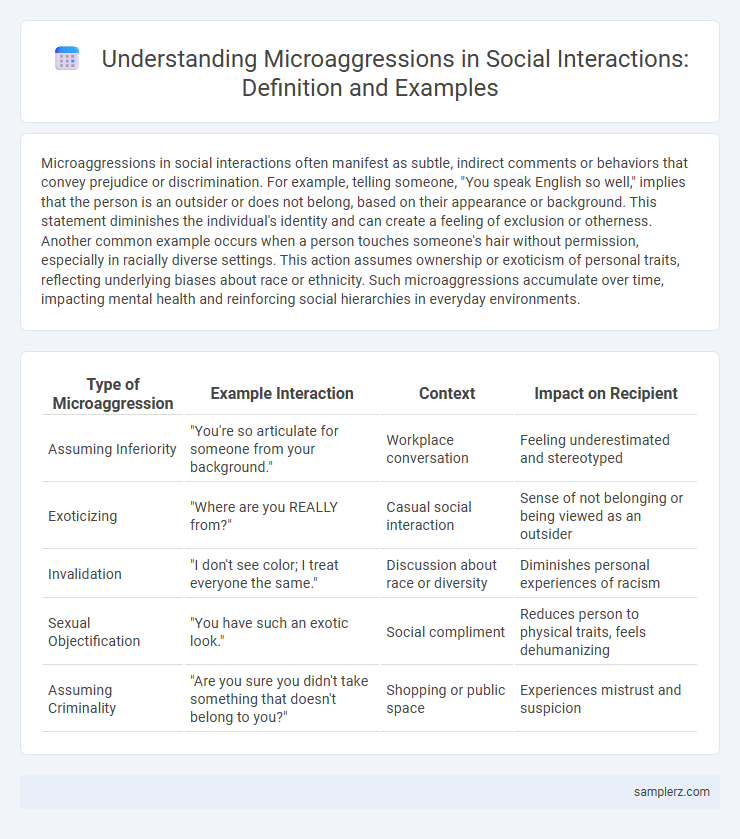Microaggressions in social interactions often manifest as subtle, indirect comments or behaviors that convey prejudice or discrimination. For example, telling someone, "You speak English so well," implies that the person is an outsider or does not belong, based on their appearance or background. This statement diminishes the individual's identity and can create a feeling of exclusion or otherness. Another common example occurs when a person touches someone's hair without permission, especially in racially diverse settings. This action assumes ownership or exoticism of personal traits, reflecting underlying biases about race or ethnicity. Such microaggressions accumulate over time, impacting mental health and reinforcing social hierarchies in everyday environments.
Table of Comparison
| Type of Microaggression | Example Interaction | Context | Impact on Recipient |
|---|---|---|---|
| Assuming Inferiority | "You're so articulate for someone from your background." | Workplace conversation | Feeling underestimated and stereotyped |
| Exoticizing | "Where are you REALLY from?" | Casual social interaction | Sense of not belonging or being viewed as an outsider |
| Invalidation | "I don't see color; I treat everyone the same." | Discussion about race or diversity | Diminishes personal experiences of racism |
| Sexual Objectification | "You have such an exotic look." | Social compliment | Reduces person to physical traits, feels dehumanizing |
| Assuming Criminality | "Are you sure you didn't take something that doesn't belong to you?" | Shopping or public space | Experiences mistrust and suspicion |
Everyday Microaggressions in Social Gatherings
Everyday microaggressions in social gatherings often manifest as subtle verbal or nonverbal slights, such as mispronouncing someone's name or consistently interrupting marginalized individuals during group conversations. These interactions can perpetuate feelings of exclusion and reinforce social inequities by invalidating personal identities and experiences. Recognizing microaggressions enables more inclusive communication and fosters respect in diverse social environments.
Subtle Slights in Group Conversations
Subtle slights in group conversations often manifest as interrupting, overlooking contributions, or consistently addressing questions to certain members while ignoring others. These microaggressions convey implicit messages of exclusion or inferiority, impacting the targeted individual's sense of belonging. Recognizing patterns such as minimizing ideas or using dismissive body language helps identify these covert social biases.
Microaggressions During Online Interactions
Microaggressions during online interactions often manifest as subtle dismissals or stereotypical comments targeting race, gender, or identity, such as assuming someone's expertise based on their profile picture or using insensitive language in chat. These behaviors can cause emotional distress and perpetuate exclusion within digital communities. Platforms like social media, forums, and virtual workspaces face challenges addressing these microaggressions effectively to foster inclusive environments.
Casual Comments That Wound
Casual comments that wound often include seemingly innocent remarks about someone's appearance, accent, or cultural background, such as saying "You're so articulate" to a person of color, which implies low expectations. These offhand remarks subtly reinforce stereotypes and create an environment where marginalized individuals feel othered or underestimated. Such microaggressions accumulate over time, causing significant psychological distress and impacting social inclusion.
Implicit Bias in Friendly Exchanges
During friendly exchanges, implicit bias can manifest when someone repeatedly interrupts a person of color, subtly signaling a lack of respect or attentiveness. These microaggressions, like assuming stereotypical traits or making unconscious jokes, communicate exclusion and reinforce social hierarchies. Recognizing such behaviors is crucial to fostering genuine inclusion and equitable social interactions.
Microaggressions Among Friends
Microaggressions among friends often manifest as subtle comments or jokes that undermine identity, such as making assumptions about cultural backgrounds or belittling personal experiences. These actions, while seemingly minor, can create feelings of exclusion and diminish trust within the friendship. Recognizing and addressing microaggressions in social interactions fosters healthier, more respectful relationships.
Unintentional Insults in Small Talk
Unintentional insults in small talk often manifest as microaggressions, such as complimenting someone's English in a way that implies it is surprising they speak it well. Comments like "Where are you really from?" suggest that the person is seen as an outsider despite being a native or long-term resident. These subtle remarks can undermine a person's identity and create feelings of exclusion in social interactions.
Stereotypes in Social Introductions
Microaggressions in social introductions often manifest through stereotypes, such as assuming someone's background or abilities based on their appearance or name. For instance, asking a person of Asian descent if they excel in math reinforces a harmful stereotype. These subtle biases can undermine individuality and perpetuate social discrimination.
Microaggressive Jokes in Social Settings
Microaggressive jokes in social settings often target marginalized groups through seemingly harmless humor that reinforces stereotypes and biases. These jokes perpetuate subtle discrimination by masking offensive content in casual conversation, making it difficult for victims to address the harm. Studies show that frequent exposure to microaggressive humor can increase feelings of exclusion and negatively impact mental health among affected individuals.
Nonverbal Cues as Microaggressions
Nonverbal cues such as eye-rolling, sighing, or avoiding eye contact often serve as subtle microaggressions that convey disrespect or dismissal in social interactions. These behaviors can undermine a person's sense of belonging and contribute to feelings of exclusion without explicit verbal communication. Recognizing and addressing nonverbal microaggressions is essential for fostering more inclusive and respectful social environments.

example of microaggression in interaction Infographic
 samplerz.com
samplerz.com